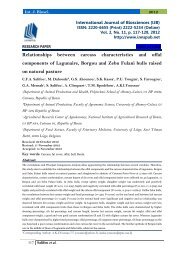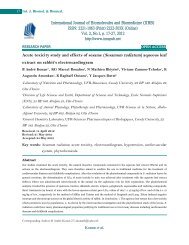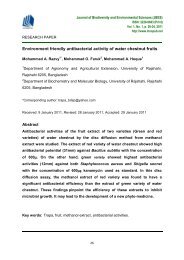Full Text - International Network for Natural Sciences | INNSPUB
Full Text - International Network for Natural Sciences | INNSPUB
Full Text - International Network for Natural Sciences | INNSPUB
Create successful ePaper yourself
Turn your PDF publications into a flip-book with our unique Google optimized e-Paper software.
Int. J. Biosci. 2013<br />
<strong>International</strong> Journal of Biosciences | IJB |<br />
ISSN: 2220-6655 (Print) 2222-5234 (Online)<br />
http://www.innspub.net<br />
Vol. 3, No. 1, p. 70-75, 2013<br />
RESEARCH PAPER<br />
OPEN ACCESS<br />
Acute toxicity of dichlorvos on tropical freshwater snail (Pila<br />
ovata)<br />
C.N. Ariole 1* , O. Ezevununwo 2<br />
1<br />
Department of Microbiology, University of Port Harcourt, P.M.B. 5323, Port Harcourt, Nigeria<br />
2<br />
School of Science Laboratory Technology, University of Port Harcourt, P.M.B. 5323, Port<br />
Harcourt, Nigeria<br />
Key words: Bioassay, freshwater snail, median lethal concentration, median lethal time.<br />
Article published on January 20, 2013<br />
Abstract<br />
The acute toxicity of dichlorvos (dimethyl 2, 2-dichlorovinyl phosphate) to freshwater snail (Pila ovata) was<br />
studied in toxicity bioassay. The test organisms were exposed to dichlorvos in a static renewal bioassay <strong>for</strong><br />
96hours. There was an initial range finding test to determine the concentrations of dichlorvos to be<br />
administered on the test organisms in the definite test. Five concentrations of the dichlorvos were prepared in<br />
the definitive test as 0.5, 1.0, 1.5, 2.0 and 2.5 ppm and a control experiment (0.0 ppm). The median lethal<br />
concentration (LC50) at 24hr, 48hr, 72hr and 96hr was 2.91, 1.74, 1.01 and 0.54ppm respectively. The median<br />
lethal time (LT50) at dichlorvos concentrations of 0.5ppm, 1.0ppm, 1.5ppm, 2.0ppm, 2.5ppm were 65.68hrs,<br />
57.91hrs, 50.91hrs, 41.54hrs and 35.56hrs respectively. Mortality increased with increase in dichlorvos<br />
concentration and the number of survivors in each concentration differ significantly (p
Introduction<br />
Pila ovata, a freshwater snail is an essential source<br />
of protein among Nigerians especially people living<br />
in the Niger Delta. The organism is widely<br />
distributed in streams, lakes and rivers across the<br />
southern rain <strong>for</strong>ests. Effluents from both natural<br />
and anthropogenic sources are discharged into water<br />
bodies in the Niger Delta either directly or indirectly<br />
through run-off, leaching or seepage especially<br />
during the rainy season. In Nigeria, many pesticides<br />
such as insecticides are available to enhance<br />
agricultural productivity and to improve public<br />
health.<br />
Pesticide is defined by United Nations Environment<br />
Programme (UNEP, 2005) as any substance or<br />
mixture of substances intended <strong>for</strong> preventing,<br />
destroying, repelling or mitigating any pest.<br />
Pesticides are widely used in the world in the control<br />
of pests on crops and on animals <strong>for</strong> vector control.<br />
One of the adverse effects of their use is the<br />
contamination of the environment which often<br />
results from direct application of pesticides into<br />
crops, animals, soil and water. It has been estimated<br />
that only about one percent of applied pesticides<br />
land on the target and that the rest contaminates the<br />
environments (Lawson et al., 2011).<br />
Dichlorvos also known as DDVP (Dimethyl 2, 2-<br />
dichlorovinyl phosphate) (USEPA, 2007) is an<br />
organophosphate insecticide and has been applied in<br />
Nigeria as insecticide over the decades since its<br />
commercial manufacture started in 1961 (BCERF,<br />
1999). Detailed risk characterization of dichlorvos<br />
has been well documented in CEPA (1996), its<br />
toxicological profile in ATSDR (1997) and<br />
environmental assessment in APVMA (2008). Most<br />
standard industrial products indicate safety<br />
in<strong>for</strong>mation which is not adhered to (Musa et al.,<br />
2010).<br />
The toxicity of dichlorvos to aquatic organisms such<br />
as ciliate of protozoa (Tetrahymena pyri<strong>for</strong>mis)<br />
(Mojzis et al., 1993), freshwater green algae<br />
(Selenastrum capricornutum) (MOE/Japan, 2002),<br />
water flea (Daphnia magna) (MOE/Japan, 2002),<br />
snail (Lymnaea accuminata) (Tripathi and Agarwal,<br />
1998) and fish (Oryzias latipes) (MOE/Japan, 2002)<br />
have been reported. Snails have been used <strong>for</strong> a<br />
purpose of bio-indicator <strong>for</strong> contamination by<br />
industrial waste dump (Pihan et al., 2000).<br />
However, there is dearth of in<strong>for</strong>mation on the<br />
toxicity of dichlorvos on the mollusc, Pila ovata.<br />
Bioassays are used to determine the toxicity of<br />
chemical substances and to indicate which<br />
organisms are the most sensitive to such chemicals<br />
(Lawson et al., 2011). These data are used to rank<br />
chemicals, determine their water quality criteria and<br />
set standards <strong>for</strong> effluent discharges (Finney, 1971).<br />
There<strong>for</strong>e, the present study aimed to determine the<br />
potential toxicity of dichlorvos (Dimethyl 2, 2-<br />
dichlorovinyl phosphate) used routinely as<br />
agricultural and household insecticide in Nigeria on<br />
freshwater snail (Pila ovata) so as to ascertain its<br />
level of tolerance and its suitability as bio-indicator<br />
in freshwater environment.<br />
Materials and methods<br />
Collection and acclimatization of test organisms<br />
The specimens of Pila ovata were collected from<br />
Okpuhur Creek in Odhieke Community in Ahoada<br />
West Local Government Area, of Rivers State,<br />
Nigeria. The specimens were brought to the<br />
laboratory in plastic container filled with oxygenated<br />
and cool habitat water to reduce their activity and<br />
stress be<strong>for</strong>e reaching the laboratory. Active and<br />
healthy organisms were selected <strong>for</strong> acclimatization.<br />
Acclimatization was <strong>for</strong> 10days at room temperature<br />
according to the static test procedure (APHA, 1998)<br />
in dilution water obtained from organism’s habitat.<br />
Bioassay<br />
The dichlorvos (DDVP 1000EC), organophosphate<br />
group, used <strong>for</strong> this experiment was purchased from<br />
a reputable shop (UZ0-Best Chemical Nigeria<br />
Limited, Port Harcourt). A range finding test was<br />
carried out as described by Rahman et al., (2002) to<br />
determine the concentrations of dichlorvos used in<br />
the definitive test. The following concentrations of
Int. J. Biosci. 2013<br />
dichlorvos were used <strong>for</strong> the definitive test- control<br />
(0.0ppm), 0.5ppm, 1.0ppm, 1.5ppm, 2.0ppm and<br />
2.5ppm. Sixty (60) specimens of juvenile Pila ovata<br />
of fairly equal size were randomly assigned in equal<br />
number (10) into six test tanks (29cm by 29cm by<br />
30cm) separately containing the definitive<br />
concentrations of dichlorvos. Each of these test tanks<br />
was replicated thrice to give a total of eighteen (18)<br />
experimental units (test tanks) containing 180<br />
specimens of Pila ovata. The control (0.0ppm)<br />
contained only 10 individuals of Pila ovata without<br />
dichlorvos. During the bioassay, the test solution in<br />
each tank was renewed every 24hours. Dead snails<br />
were promptly removed and mortality was<br />
specifically recorded at 24, 48, 72 and 96 hours of<br />
exposure time as described by Odiete (1999).<br />
of 0.5, 1.0, 1.5, 2.0 and 2.5ppm were 65.68hr,<br />
57.91hr, 50.91hr, 41.54hr and 35.56hr respectively<br />
(Fig. 2 and Table 2). The LC50 of dichlorvos vary<br />
considerably when previous reports on invertebrates<br />
are compared and also with LC50 values obtained in<br />
this study.<br />
Table 1. Median lethal concentration (LC50) of<br />
dichlorvos to Pila ovate.<br />
Time (hr)<br />
LC50 (PPM)<br />
24 2.91<br />
48 1.74<br />
72 1.01<br />
96 0.54<br />
Statistical analysis<br />
Each test concentration and the corresponding<br />
percentage mortality were trans<strong>for</strong>med into probit<br />
(Sprague, 1973). The median lethal concentration<br />
(LC50) and median lethal time (LT50) were<br />
determined according to the method described by<br />
Finney (1971). Analysis of variance (ANOVA) was<br />
used to test <strong>for</strong> significant differences in the number<br />
of survivors in different concentrations of the<br />
toxicants (dichlorvos).<br />
Results and discussion<br />
Results obtained showed that generally, percentage<br />
mortality increased with increasing concentration of<br />
dichlorvos (Fig. 1) and with increase in exposure<br />
time (Fig. 2). The LC50 and LT50 were obtained from<br />
the probit graph (Finney, 1971). The 24, 48, 72 and<br />
96hr median lethal concentration (LC50) of<br />
dichlorvos to Pila ovata were 2.91, 1.74, 1.01 and<br />
0.54 respectively (Table 1). The result showed that<br />
the LC50 value of dichlorvos to Pila ovata decreased<br />
as the exposure time increased (Table 1). The<br />
correlation coefficient (r 2 ) between concentration of<br />
the dichlorvos and probit mortality showed that<br />
there were strong and positive correlations between<br />
concentration and mortality values <strong>for</strong> 24, 48, 72 and<br />
96hr (Fig. 1). The median lethal time (LT50) of<br />
dichlorvos to Pila ovata at dichlorvos concentrations<br />
Table 2. Median lethal time (LT50) of dichlorvos to<br />
Pila ovate.<br />
Concentration<br />
Time (hr)<br />
(ppm)<br />
0.5 65.68<br />
Table 3.<br />
1.0 57.91<br />
1.5 50.91<br />
2.0 41.54<br />
2.5 35.56<br />
Survivors of Pila ovata exposed to<br />
different concentrations of dichlorvos.<br />
Concentration Survival (%) (mean ±<br />
(ppm)<br />
S.D.)<br />
Control (0) 100 a ± 0.00<br />
0.5 23.33 b ± 0.77<br />
1.0 20 c ± 0.77<br />
1.5 15.33 d ± 0.77<br />
2.0 9.67 c ± 0. 77<br />
2.5 3.33 f ± 0.77<br />
Mean values which do not have the same superscript<br />
letter are significantly different (p
Int. J. Biosci. 2013<br />
been reported in freshwater crustacea, water fleas,<br />
scud, mosquito, midge, shell (snail) and oligochaete.<br />
Results showed that the 48hr EC50 values of<br />
immobilization in water flea were 0.000144 and<br />
0.000266mg/L (Brooke, 1991; MOE/Japan, 2002),<br />
the 96hr LC50 in minaminuma shrimp was<br />
0.00719mg/L (MOE/Japan, 2002) and 96hr LC50 in<br />
one of freshwater pulmonate (Physella virgata) was<br />
0.17mg/L (Brooke, 1991). In addition, the LC50<br />
values ranged from 0.0158 to 0.0176mg/L in insects<br />
and 0.0075 to 0.31mg/L in shell (snail), which<br />
indicates strong effects of dichlorvos on these<br />
organisms similar to those on crustacean (CERI,<br />
2007) and the result obtained in this study.<br />
may result in different patterns of biotrans<strong>for</strong>mation,<br />
leading to more or less toxic metabolites (Johnson<br />
and Toledo, 1993). The magnitude of toxic effects of<br />
pesticide also depends on length and weight,<br />
corporal surface/body weight ratio and breathing<br />
rate (Murty, 1986). Metabolic differences between<br />
different animal classes may also be responsible <strong>for</strong><br />
differential toxicity of chemicals.<br />
The number of survivors of Pila ovata exposed to<br />
different concentrations of dichlorvos differ<br />
significantly (p
Int. J. Biosci. 2013<br />
Medicines Authority, APVMA, P. O. BOX E 240<br />
KINGSTON ACT 2604 Australia pp.1-71.<br />
Environmental Contaminaton and Toxicology 24,<br />
151-155.<br />
APHA. 1998. Standard Methods <strong>for</strong> the<br />
Examination of Water and Wastewater 20 th ed.<br />
American Public Health Association, Washington,<br />
D.C.<br />
ATSDR. 1997. Toxicological Profile <strong>for</strong> Dichlorvos.<br />
Agency <strong>for</strong> Toxic Substances and Disease Registry.<br />
U.S. Department of Health and Human Services,<br />
Public Health service 1600 Clifton Road NE, E-29<br />
Atlanta, Georgia 30333, p. 1-119.<br />
Lawson EO, Ndimele PE, Jimoh AA, Whenu<br />
OO. 2011. Acute toxicity of Lindane (Gamma<br />
Hexachloro-Cyclohexane) to African catfish (Clarias<br />
gariepinus, Burchell, 1822). <strong>International</strong> Journal of<br />
Animal and Veterinary Advances 3(2), 63-68.<br />
MOE /Japan, 2002. Ministry of the Environment,<br />
(MOE), Japan Contract report, study <strong>for</strong> ecological<br />
effect of agricultural chemicals in FY 2001,<br />
Chemicals Evaluation and Research Institute, Japan.<br />
(In Japanese).<br />
BCERF. 1999. Pesticides and Breast Cancer Risk.<br />
An Evaluation of Dichlorvos in New York State<br />
Institute <strong>for</strong> Comparative and Environmental<br />
Toxicology. Cornell Center <strong>for</strong> the Environment.<br />
Breast Cancer and Environmental Risk Factors.<br />
FACT SHEET 20, 1-4.<br />
Brooke LT. 1991. Results of freshwater exposures<br />
with the chemicals- atrazine, biphenyl, butachlor,<br />
carbaryl, carbazole, dibenzofuran, 3, 3-<br />
dichlorobenzidine and dichlorvos. Center <strong>for</strong> Lake<br />
Superior Environmental Study, Univ. of Wisconsin-<br />
Superior, WI, 110.<br />
Mojzis J, Mojzisova G, Nistiar F. 1993. The<br />
effect of dichlorvos and polychlorinated biphenyl<br />
(Delor 103)On the protozoon Tetrahymena<br />
pyri<strong>for</strong>mis. Biologia (Bratisl.) 48, 349-354.<br />
Murty AS. 1986. Toxicity of Pesticides to Fish. CRC<br />
Press Inc., Boca Raton, FL, USA, p. 143.<br />
Musa U, Hati SS, Mustapha A, Magaji G. 2010.<br />
Dichlorvos concentrations in locally<br />
<strong>for</strong>mulated pesticide (ota-piapia) utilized<br />
innortheastern Nigeria. Scientific Research and<br />
Eassy 5 (1), 49-54.<br />
CEPA. 1996. Dichlorvos (DDVP). Risk<br />
Characterization Document, Medical Toxicology and<br />
Worker Health and Safety Branches, Department of<br />
Pesticide Regulation, Cali<strong>for</strong>nia Environmental<br />
Protection Agency, U.S.A. p. 1-119.<br />
CERI. 2007. Hazard Assessment Report, DimethyI<br />
2, 2-dichlorovinyl Phosphate (synonyms: Dichlorvos,<br />
DDVP), Chemical Evaluation and Rasearch Institute<br />
(CERI), Japan. CAS No. 62-73-7.<br />
Finney DJ. 1971. Probit Analysis. 3 rd edition<br />
Cambridge University Press, London, p. 333.<br />
Johnson CM, Toledo MCF. 1993. Acute toxicity<br />
of endosufan to the fish Hypessbrycon bifasciatus<br />
and Branchydancon rerio. Archives of<br />
Odiete WO. 1999. Environmental Physiology of<br />
Animals and Pollution. Diversified Resources, Ltd.,<br />
Lagos, Nigeria.<br />
Pihan F. Vaufleury A. 2000. The snail as a target<br />
organism <strong>for</strong> the evaluation of industrial waste dump<br />
contamination and the efficiency of its remediation.<br />
Ecotoxicology and Enviromental Safety 46, 137-147.<br />
Rahman MZ, Hossain Z, Mollah MFA, Ahmed<br />
GU. 2002. Effect of diazinum60EC on Anabas<br />
testudineus, Channa punctatus and Barbodes<br />
gonionotus “Naga’’. The ICLARM Quarterly<br />
25, 8-12.<br />
Sprague JB. 1973. The ABCs of pollutants bioassay<br />
using fish. In: Biological methods <strong>for</strong> assessment of<br />
74 Ariole and Ezevununwo
Int. J. Biosci. 2013<br />
water quality Cairns J. Jr. and Dickson, K. L. (eds.),<br />
ASTM Special Tech. Public. 528, 6-30.<br />
Tripathi AM, Agarwal RA. 1998. Molluscicidal<br />
and anti-AChE activity of tertiary mixtures of<br />
pesticides. Archives of Environmental<br />
Contamination and Toxicology 34, 271-274.<br />
UNEP. 2005. Ridding the world of Persistent<br />
Organic Pollutants: A guide to the Stockholm<br />
convention on persistent organic pollutants. United<br />
Nations Environment Programme, 11-13, Chemin des<br />
Anemone, CH-1219, Chatelaine, Geneva,<br />
Switzerland, p. 24.<br />
75 Ariole and Ezevununwo








